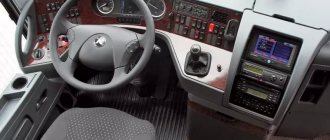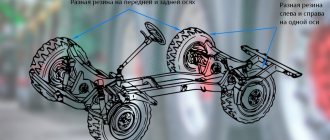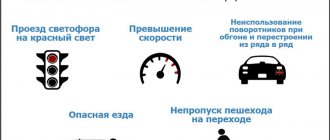Array ( [DATE_ACTIVE_FROM] => 09/14/2020 09:00:00 [~DATE_ACTIVE_FROM] => 09/14/2020 09:00:00 [ID] => 509667087 [~ID] => 509667087 [NAME] => Tachograph for ZIL Is 130 necessary [~NAME] => Is a tachograph needed on ZIL 130 [IBLOCK_ID] => 33 [~IBLOCK_ID] => 33 [IBLOCK_SECTION_ID] => [~IBLOCK_SECTION_ID] => [DETAIL_TEXT] => Many motorists are interested in whether it is necessary tachograph on a ZIL dump truck. And if we turn to our Russian legislation, it turns out that in accordance with one of the orders from the Ministry of Transport, it is necessary to install the device, but there are certain exceptions. It is designed to record the time spent by the driver on driving the car, as well as others manipulation.Therefore, you should first familiarize yourself with all its nuances and installation rules.
Purpose and types of device
The tachograph can be compared to the “black box” on an airplane in terms of its operating principles. The main function is to register the machine’s movement parameters and store this information in memory. Employees and management can then view the history. In general, the device is used to monitor compliance with the work regime and rest of subordinates. What modern tachographs do:
- record the vehicle's mileage and its speed;
- mark the time of driving, breaks and other work performed by the driver;
- register all data, encrypt it and save it in a form protected from editing.
The last option that the device performs is especially important.
The information he recorded is as reliable as possible and cannot be changed. It can be used as evidence in resolving controversial issues. The data recorded by the device is accepted in court. There are 2 main types of devices: analog and digital tachograph. The first version of the control device is more practical; it is installed on ZIL more often. Information is recorded thanks to a cryptographic module with increased data storage capacity, a global positioning system.
What is it for?
The original task of the tachograph was to preserve the life of the driver and other road users.
The device has proven itself well as a means of preventing road accidents:
- Thanks to a modern system for transmitting data on the speed of a vehicle, the device prevents violations of the speed limit established on the highway. This often happens to truck drivers who, due to the large amount of time spent behind the wheel, lose concentration and may not notice an accidental violation.
- To monitor the driver’s condition, time intervals of wakefulness and rest are monitored, thereby preventing the person from becoming overtired at work.
The standards are established in accordance with Order of the Ministry of Transport of the Russian Federation No. 484 dated December 24, 2013.
Data transmission is based on the GLONASS global positioning system. This allows you to increase the accuracy of the transmitted information and its effectiveness. Cryptographic encryption is used to protect information stored in the device.
This security system helps prevent access to data and its further modification for fraudulent and criminal purposes.
Each tachograph must have a certificate:
- It is necessary for correct work with law enforcement agencies.
- These devices are indisputable evidence in criminal and administrative cases.
An integral part of the device is the tachograph card. It is necessary for the presence of memory in the device. The traffic police officer has the right to request not only documentation, but also this key.
Devices are divided into two main types:
- Digital. At the heart of these devices is a cryptographic module that allows you to create sufficient protection for your data.
- Analog. Such devices are obsolete, since data is recorded on a diagram in accordance with sensor signals.
The device must be installed on any vehicle whose maximum weight exceeds 3.5 tons:
- M2 - transport for the transport of passengers, having less than 8 seats, with a total weight of no more than 5 tons;
- M3 - transport for the transport of passengers, having more than 8 seats, with a total weight of more than 5 tons;
- N2 - transport for transporting cargo weighing no more than 12 tons;
- N3 - transport for transporting cargo weighing more than 12 tons.
No control required:
- on buses traveling around the city and suburbs;
- on vehicles traveling between countries that already have devices that meet domestic standards;
- Vehicles used on construction sites;
- educational vehicles;
- when passing road tests;
- if the car is more than 30 years old;
- trolleybuses;
- for military transport.
Operating principles of the device
The main tachograph unit is located in the cab of the car so that the driver has access to the external control panel. Modern models have screens that display basic information about system operation. When the engine is turned off, due to the powerful battery, the device operates in autonomous mode. It also contains a volatile memory module, therefore, the recorded information is saved 100%. To transmit information about the movement of the car, a speed sensor is connected to the device using standard sockets.
To start using the device, you need to install a personal driver card - a key card. Only then will information be correctly recorded and stored in memory. The cards contain special chips with a limited service life. Periodically, they require reissue. Driver cards are personalized, that is, they are made in the name of the person who will drive the car. The main task is to identify the person who drove the freight transport in a certain period of time.
Responsibility for the absence of a tachograph
An administrative violation is considered to be cases when the device is not in a vehicle engaged in a commercial flight. Accordingly, the person who carries out illegal actions must be punished. The responsibility before the law lies not only with the person driving the transport, but also with the organization itself that put the car on the route.
The amount of fines is determined individually by the traffic police officer who recorded the violation. Traveling without a monitoring device is a major non-compliance with the rule. The moments, if any, are equated to this situation, but it does not perform the proper functions:
- switched off;
- faulty;
- has not been certified;
- unauthorized modified
.
Violation of the law also occurs in the following cases:
- When there is no driver card or motion sensor available.
- The case does not have a seal or protection against burglary.
- No cryptographic or software required.
- The necessary sensors or visual and audible warnings are missing.
Liability for the absence of a tachograph is the main type of violation of the law, for which a fine is issued. But the situation also implies a malfunction of the device, its incorrect operation and untimely switching on/off.
Algorithm for working with the device
To eliminate cases of improper operation, we will describe the correct sequence of actions when working with the device:
- Before the start of the trip, the driver of the vehicle is required to insert a personal card and enter a PIN code upon request. If there is a second driver, his card is also inserted into the adjacent slot at the same time.
- The location coordinates are automatically determined. Sometimes you need to enter this data yourself manually.
- Throughout the entire route, the tachograph is turned on, and the card is present in the required slot. The trip details are recorded.
- Confiscation of personal identification occurs only upon arrival at the destination or end of the shift.
- In cases of non-compliance with the described algorithm, incorrect data recording occurs, the sequence mode is not determined and incorrect information is provided upon request. Consequently, a driver who violates the rules of use is subject to fines and warnings.
A tachograph is a device that monitors the condition of the person driving and the vehicle along the entire route. Using the device protects people and cargo from damage and accidents. Its absence carries great risks and penalties for the driver and car owner. Therefore, on the road, it is better to use the device every time to control the driving mode and to avoid additional fines.
Do you still have questions?
Call right now 8-909-642-03-40 or write to us back to contents
What does the law say about the tachograph on ZIL?
Documents adopted by the legislation of the Russian Federation strictly control freight transport with devices for recording traffic parameters. This is necessary to prevent the exploitation of state-owned dump trucks by employees for personal purposes, conflicts between superiors and subordinates, and illegal activities of private owners.
So, is a tachograph required for a ZIL according to the law, and what main documents confirm this:
- Customs Union Regulation 018/2011, which includes criteria for the design of cargo vehicles;
- Federal Law No. 196 of July 26, 2017 “On Road Traffic Safety”, obliging car owners to equip them with monitoring devices;
- Order of the Ministry of Transport of the Russian Federation No. 237 dated 08/21/13, which states what specific devices are equipped with vehicles operating on commercial flights.
The above standards apply to trucks weighing 3,500 kg and above. The weight of all types of dump trucks exceeds this mark; accordingly, the law applies to them.
.
Is it necessary to install a tachograph on a personal ZIL?
Most truck owners believe that they do not have to equip their vehicle with a monitoring device, since they do not work for a company and conduct private business. But, due to changes in legislation, this judgment is now erroneous. Whether a tachograph on a ZIL 130 is needed or not previously depended on the purpose of its operation by the driver. This is the most popular type of truck, which is used in construction work, commercial and passenger transportation. Today, the answer is unequivocal - yes. Until November 1, 2019, it was necessary to install monitoring devices only for cars operated by legal entities. This meant that private owners were exempt. But, from November 1, 2021, a new clause has been added to the Law “On Road Traffic Safety”.
From November 1, 2021, the device must be installed on private trucks of category C. This rule also applies to private buses of category D. If the tachograph on the ZIL 130 has not been installed, that is, the driver carries out business activities without state registration, he faces a fine of 500 to 2000 rubles.
Fine for driving without a tachograph for individuals in 2021
Operating vehicles for commercial purposes requires the installation of special equipment. The absence of a tachograph, as well as an expired card or its absence is fraught with the imposition of a fine on both an individual and an individual entrepreneur. Since the representative of the individual entrepreneur is an official, the amount of the penalty for him will be slightly larger than for an ordinary driver:
| Violation | Individual | IP |
| Lack of equipment | 1000-3000 | 5000-10000 |
| The tachograph is not working | 1000-3000 | 5000-10000 |
| The work and rest schedule is disrupted | 1000-3000 | 5000-10000 |
| The driver does not have an active card or uses someone else’s card when operating the vehicle | 1000-3000 | 5000-10000 |
Advantages of the device
Of course, based on new changes in legislation, installation of a tachograph is mandatory for everyone. But, you should not perceive this as an unnecessary burden. If you equip your car with the device, it will give a lot of advantages.
So, what are the advantages of installing a control device on ZIL:
- you can transport cargo and passengers throughout Russia and the countries of the European Union;
- additionally, the safety of vehicle movement on the road is guaranteed - any speeding or overtime is recorded, this will not allow the employee to evade his tasks;
- the vehicle's payback increases, since the tachograph includes unauthorized trips, deviations from the route, which makes it possible to control mileage and working time on the road;
- allows you to calculate the most optimal route.
According to reviews from entrepreneurs, after installing the device, the productivity of employees increases due to strict control of their activities during working hours.
Features of using the device
After the tachograph is installed, you should familiarize yourself with the nuances of operation. These include:
- after installation, receive a license from the Federal Security Service;
- every 3 years the device must be calibrated, and if it was purchased with CIPF, the unit is replaced or activated once every 3 years;
- When a vehicle is leased or sold, the control device must be dismantled and the device must be disposed of.
The driver's card also changes every three years.
Which cars can be installed with a tachograph?
For legal entities and individuals, these are all cars with a tonnage from 3.5 to 12 tons and buses with more than eight seats. Exceptions are specified in Order of the Ministry of Transport No. 36. In short, these are special and agricultural equipment such as a concrete mixer, milk tanker, combine harvester or military equipment. The driver or owner of this equipment will not receive a fine for not having a tachograph card or the device itself. Many drivers ask: do they need a tachograph for a gazelle? The answer is that it is necessary if it is a passenger gazelle with more than eight seats. It is not needed for a cargo gazelle up to 3.5 tons.
How to install a tachograph
To equip a vehicle with a device, contact a service center. The company must have the appropriate permits. These organizations are registered with Rosavtotrans and are issued licenses to work with cryptographic equipment. You will not be able to carry out the installation procedure yourself.
The installation process for the device is as follows:
- when ZIL is being prepared for installation, specialists select a place to install the tachograph in such a way that the driver can carry out manipulations without being distracted from driving; this requires the installation of special brackets or the laying of routes to connect the system;
- the device is unpacked, connected to the on-board network, speed sensor, connections are isolated;
- The tachograph together with the cryptographic module is activated, after which the device is calibrated to ensure the accuracy of the collected data.
At the end of the installation process, the instrument housing is sealed. Manipulation is needed to protect the system from interference, attempts to edit information, or malicious damage. When the device is packaged in a sealed case, it is placed in the slot and secured.
A tachograph is a useful device both for superiors to monitor the work of subordinates, and for private entrepreneurs involved in passenger or cargo transportation.
[~DETAIL_TEXT] =>
Many motorists are interested in whether a ZIL dump truck needs a tachograph. And if we turn to our Russian legislation, it turns out that in accordance with one of the orders from the Ministry of Transport, it is necessary to install the device, but there are certain exceptions. It is designed to record the time spent by the driver driving the car, as well as other manipulations. Therefore, you should first familiarize yourself with all its nuances and installation rules.
For whom installation is required
In accordance with Federal Law No. 196, this item is installed in commercial vehicles, including passenger and cargo vehicles under categories M2, M3, H2, H3.
It follows from this that the equipment should be:
- vehicles with a passenger capacity of more than 8 pieces;
- a vehicle for transporting goods of more than 3.5 tons, but not exceeding 12 tons.
Commercial international buses and duty buses that transport employees to their places of work should be equipped.
Exceptions
There is no need to install the device on:
- trolleybuses;
- buses of categories M2 and M3, which make regular trips to transport citizens. The distance should not exceed 50 kilometers in one direction;
- vehicles created to ensure law and order, firefighting, medical and rescue vehicles with appropriate designations;
- vehicles for military inspection;
- private vehicles with a mass not exceeding the indication of 7.5 tons.
The device is not required for installation in the following cases:
- there is a KAMAZ truck at the construction site;
- when equipping a vehicle with lifts and a manipulator.
Purpose and types of device
The tachograph can be compared to the “black box” on an airplane in terms of its operating principles. The main function is to register the machine’s movement parameters and store this information in memory. Employees and management can then view the history. In general, the device is used to monitor compliance with the work regime and rest of subordinates.
What modern tachographs do:
- record the vehicle's mileage and its speed;
- mark the time of driving, breaks and other work performed by the driver;
- register all data, encrypt it and save it in a form protected from editing.
The last option that the device performs is especially important. The information he recorded is as reliable as possible and cannot be changed. It can be used as evidence in resolving controversial issues. The data recorded by the device is accepted in court.
There are 2 main types of devices: analog and digital tachograph. The first version of the control device is more practical; it is installed on ZIL more often. Information is recorded thanks to a cryptographic module with increased data storage capacity, a global positioning system.
Operating principles of the device
The main tachograph unit is located in the cab of the car so that the driver has access to the external control panel. Modern models have screens that display basic information about system operation. When the engine is turned off, due to the powerful battery, the device operates in autonomous mode. It also contains a volatile memory module, therefore, the recorded information is saved 100%. To transmit information about the movement of the car, a speed sensor is connected to the device using standard sockets.
To start using the device, you need to install a personal driver card - a key card. Only then will information be correctly recorded and stored in memory. The cards contain special chips with a limited service life. Periodically, they require reissue. Driver cards are personalized, that is, they are made in the name of the person who will drive the car. The main task is to identify the person who drove the freight transport in a certain period of time.
What does the law say about the tachograph on ZIL?
Documents adopted by the legislation of the Russian Federation strictly control freight transport with devices for recording traffic parameters. This is necessary to prevent the exploitation of state-owned dump trucks by employees for personal purposes, conflicts between superiors and subordinates, and illegal activities of private owners.
So, is a tachograph required for a ZIL according to the law, and what main documents confirm this:
- Customs Union Regulation 018/2011, which includes criteria for the design of cargo vehicles;
- Federal Law No. 196 of July 26, 2017 “On Road Traffic Safety”, obliging car owners to equip them with monitoring devices;
- Order of the Ministry of Transport of the Russian Federation No. 237 dated 08/21/13, which states what specific devices are equipped with vehicles operating on commercial flights.
The above standards apply to trucks weighing 3,500 kg and above. The weight of all types of dump trucks exceeds this mark; accordingly, the law applies to them.
.
Is it necessary to install a tachograph on a personal ZIL?
Most truck owners believe that they do not have to equip their vehicle with a monitoring device, since they do not work for a company and conduct private business. But, due to changes in legislation, this judgment is now erroneous. Whether a tachograph on a ZIL 130 is needed or not previously depended on the purpose of its operation by the driver. This is the most popular type of truck, which is used in construction work, commercial and passenger transportation. Today, the answer is unequivocal - yes. Until November 1, 2019, it was necessary to install monitoring devices only for cars operated by legal entities. This meant that private owners were exempt. But, from November 1, 2021, a new clause has been added to the Law “On Road Traffic Safety”.
From November 1, 2021, the device must be installed on private trucks of category C. This rule also applies to private buses of category D. If the tachograph on the ZIL 130 has not been installed, that is, the driver carries out business activities without state registration, he faces a fine of 500 to 2000 rubles.
Law on Tachograph Requirements
Requirements for tachographs, rules for their use and control, as well as types of vehicles for which this device is mandatory, are approved by Order of the Ministry of Transport of the Russian Federation dated February 13, 2013 N 36 (Appendix No. 1).
Among the mandatory requirements, in addition to a tamper-proof and sealed unit of the device, the following is provided:
- tachograph and motion sensor cards; visual and audio warning means, etc.
- antennas for receiving and transmitting GSM/GPRS signals (if a communication module is included in the on-board device) and for receiving signals from the global navigation satellite systems GLONASS and GPS.
- necessary software and cryptographic support.
The tachograph is equipped with a printing device and a keyboard for entering information. Depending on the mode, it works with four types of cards: driver, controller, workshop and enterprise.
The device allows you to obtain complete and reliable information and identify attempts to correct and falsify it in the tachograph memory.
Operating rules
- Before leaving, the driver activates the tachograph with his personal card and enters the PIN code.
- If there is a second driver, he also inserts his card and enters the password.
- Next, the necessary data is entered manually or registered automatically.
- Drivers’ personal cards are retrieved at the end of the shift, after confirmation of the place of completion of work.
Note : Traffic police fines? If an old-style tachograph that meets all EU standards was installed in the car before 2014, it must be replaced with a new one before 2019.
A tachograph is a device that allows you to monitor speed data, track the route of movement of a vehicle, the time frame for rest and activity of the driver.
The device consists of:
- GPS navigator;
- antennas for establishing a signal via satellite;
- motion sensor;
- protective seal.
Advantages of the device
Of course, based on new changes in legislation, installation of a tachograph is mandatory for everyone. But, you should not perceive this as an unnecessary burden. If you equip your car with the device, it will give a lot of advantages.
So, what are the advantages of installing a control device on ZIL:
- you can transport cargo and passengers throughout Russia and the countries of the European Union;
- additionally, the safety of vehicle movement on the road is guaranteed - any speeding or overtime is recorded, this will not allow the employee to evade his tasks;
- the vehicle's payback increases, since the tachograph includes unauthorized trips, deviations from the route, which makes it possible to control mileage and working time on the road;
- allows you to calculate the most optimal route.
According to reviews from entrepreneurs, after installing the device, the productivity of employees increases due to strict control of their activities during working hours.
Features of using the device
After the tachograph is installed, you should familiarize yourself with the nuances of operation. These include:
- after installation, receive a license from the Federal Security Service;
- every 3 years the device must be calibrated, and if it was purchased with CIPF, the unit is replaced or activated once every 3 years;
- When a vehicle is leased or sold, the control device must be dismantled and the device must be disposed of.
The driver's card also changes every three years.
Installation delays and deadlines
When purchasing vehicles of categories N2/N3 and M2/M3, tachographs must already be installed. But if a citizen or organization purchased a truck that does not have a device, then operation of such a vehicle is possible only after installing the device.
When releasing a vehicle without a tracking system, several fines will be issued to the person, since the appearance of such trucks for work is prohibited by the legislation of the Russian Federation.
Penalties will be directed not only at the driver, but also at the officials who allowed the car to enter the route without the device.
The legislation determined more lenient penalties for those who use outdated tachographs installed before April 2014.
But from the beginning of 2021, all outdated tachographs must be replaced with modern devices with cryptographic protection:
- If the car will be used only in Russia, then a CIPF is required.
- If the car will be used on international flights, then the AETR is required.
CIPF is a means of cryptographic information protection. The production and licensing of such modules is controlled by the Federal Security Service of the Russian Federation.
It is necessary to prevent editing of existing information. The block looks like a housing element with technical outputs and connectors.










